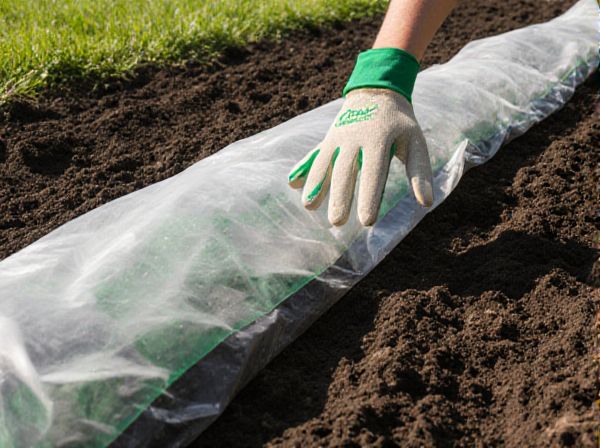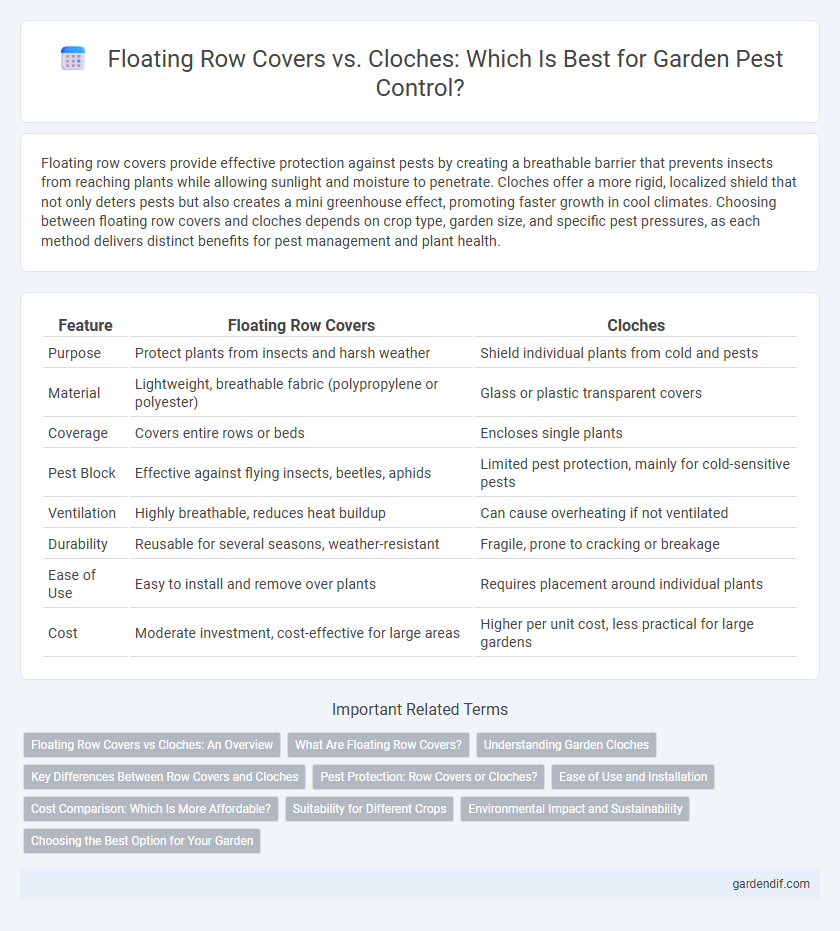
Floating row covers vs cloches Illustration
Floating row covers provide effective protection against pests by creating a breathable barrier that prevents insects from reaching plants while allowing sunlight and moisture to penetrate. Cloches offer a more rigid, localized shield that not only deters pests but also creates a mini greenhouse effect, promoting faster growth in cool climates. Choosing between floating row covers and cloches depends on crop type, garden size, and specific pest pressures, as each method delivers distinct benefits for pest management and plant health.
Table of Comparison
| Feature | Floating Row Covers | Cloches |
|---|---|---|
| Purpose | Protect plants from insects and harsh weather | Shield individual plants from cold and pests |
| Material | Lightweight, breathable fabric (polypropylene or polyester) | Glass or plastic transparent covers |
| Coverage | Covers entire rows or beds | Encloses single plants |
| Pest Block | Effective against flying insects, beetles, aphids | Limited pest protection, mainly for cold-sensitive pests |
| Ventilation | Highly breathable, reduces heat buildup | Can cause overheating if not ventilated |
| Durability | Reusable for several seasons, weather-resistant | Fragile, prone to cracking or breakage |
| Ease of Use | Easy to install and remove over plants | Requires placement around individual plants |
| Cost | Moderate investment, cost-effective for large areas | Higher per unit cost, less practical for large gardens |
Floating Row Covers vs Cloches: An Overview
Floating row covers provide lightweight, breathable protection for crops, effectively deterring pests like aphids and beetles while allowing light and moisture to reach plants. Cloches, typically made of glass or plastic, create a mini greenhouse environment that not only shields plants from insects but also retains heat, accelerating growth in cooler climates. Choosing between floating row covers and cloches depends on factors such as crop type, pest pressure, and climate conditions to optimize pest management and plant health.
What Are Floating Row Covers?
Floating row covers are lightweight, permeable fabrics used to protect plants from pests while allowing sunlight, air, and water to reach the crops. These covers create a physical barrier against insects such as aphids, caterpillars, and beetles, reducing the need for chemical pesticides and promoting healthier plant growth. Unlike cloches, floating row covers can be easily placed over rows of plants without the need for support structures, making them a flexible and cost-effective pest management solution.
Understanding Garden Cloches
Garden cloches provide a protective microenvironment for plants, shielding them from pests such as aphids, flea beetles, and caterpillars while maintaining warmth and humidity. Unlike floating row covers that drape directly over crops, cloches are rigid, often made of glass or plastic, allowing better airflow and easier access for maintenance. Their effectiveness in pest control combined with frost protection makes cloches an essential tool for early-season gardening and extending the growing period.
Key Differences Between Row Covers and Cloches
Row covers provide broad protection over multiple plants by creating a lightweight fabric barrier against pests, while cloches serve as individual plant enclosures, offering more targeted shielding. Floating row covers are breathable and flexible, allowing sunlight, air, and rain to penetrate, whereas cloches are typically rigid, forming a mini-greenhouse effect that traps warmth. The key difference lies in coverage scope and material design, with row covers suited for larger garden areas and cloches ideal for protecting young or delicate plants from specific threats.
Pest Protection: Row Covers or Cloches?
Floating row covers provide a lightweight, breathable barrier that effectively protects plants from flying insects like aphids, beetles, and leafhoppers while allowing sunlight and moisture to reach the crops. Cloches offer targeted, enclosed protection, shielding young seedlings from pests such as slugs, caterpillars, and birds, but may limit airflow and require frequent monitoring to prevent overheating. Choosing between floating row covers and cloches depends on the specific pest threats, crop type, and environmental conditions to maximize pest control and plant health.
Ease of Use and Installation
Floating row covers offer greater ease of use with lightweight, flexible fabric that can be quickly placed over crops without the need for rigid supports. Cloches require more effort for installation as they involve setting up individual protective domes, often made from glass or plastic, which can be time-consuming and less adaptable to varying plant sizes. For pest control, floating row covers provide faster deployment and removal, enhancing convenience while maintaining effective protection.
Cost Comparison: Which Is More Affordable?
Floating row covers generally offer a more affordable pest protection solution compared to cloches, as they cover larger garden areas with a single purchase and are reusable across multiple seasons. Cloches, being smaller and designed for individual plants, require higher upfront investment when protecting extensive garden beds due to the need for multiple units. Considering materials, floating row covers often use lightweight, breathable fabrics that balance durability and cost-effectiveness, while cloches made from glass or rigid plastic tend to be pricier and prone to damage or loss.
Suitability for Different Crops
Floating row covers provide lightweight, breathable protection ideal for leafy greens, strawberries, and root vegetables, allowing sunlight and moisture to pass while shielding against pests and frost. Cloches, typically made of glass or plastic, create a warm, greenhouse-like environment perfect for tomatoes, peppers, and other heat-loving crops, enhancing early growth and extending the growing season. Both options improve pest management, but selection depends on crop sensitivity, growth habit, and climate conditions.
Environmental Impact and Sustainability
Floating row covers offer a reusable and biodegradable option that reduces pesticide use by providing natural pest barriers, minimizing chemical runoff and soil contamination. Cloches, typically made from glass or plastic, often have a higher environmental footprint due to manufacturing emissions and waste generation, though reusable cloches can mitigate some impact. Choosing floating row covers supports sustainable pest management through lower material waste and enhanced soil health preservation.
Choosing the Best Option for Your Garden
Floating row covers provide lightweight, breathable protection against pests and harsh weather, ideal for covering large garden areas quickly. Cloches offer a more durable, reusable solution that creates a mini-greenhouse effect, promoting faster plant growth while shielding delicate crops from insects and frost. Selecting the best option depends on your garden size, types of plants, and pest pressure, with row covers favored for broad coverage and cloches preferred for targeted, intensive protection.
Floating row covers vs cloches Infographic

 gardendif.com
gardendif.com